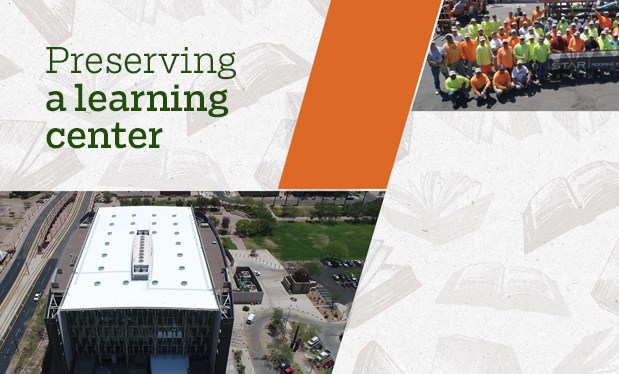As our society strives to find ways to reuse materials, the challenge of how to handle plastic waste is front and center. Plastic waste is a growing global problem; although recycling efforts have been around for decades, overall plastic recycling rates remain low.
But various industries, including roofing, are finding materials made from recycled polymers can add value and enhance the performance of their products. This provides an economically sound and beneficial avenue for recycling and reuse, creating the potential for a more "circular economy" for plastic waste.
The plastic waste problem
Since large-scale commercial production of plastics began in the 1950s, their use has grown exponentially. Lightweight, durable and versatile, plastics are modern society's material of choice in countless applications and as a replacement for glass, steel, wood and other materials. But with the ever-increasing production of plastics comes the challenge of what to do with them after initial use. The sheer size and scale of global plastic waste is staggering.
A study conducted by the University of Georgia, Athens, in July 2017 estimates that of the 8.3 billion tons of plastics produced from the early 1950s through 2017, 79 percent (more than 6.5 billion tons) resides in landfills or the environment. Of the remaining plastic, 12 percent was incinerated and less than 9 percent was recycled during the past few decades for reuse.
Recycling rates have increased over the years but remain low. In 2017, more than 400 million metric tons of virgin plastics were manufactured globally. Of that overall production, less than 30 percent was recycled, and more than 40 percent went into packaging materials, which typically have a life span of less than six months before being discarded.
Although rates vary by country and region, the overall U.S. recycling rate of 9 percent lags significantly behind Europe (30 percent) and China (25 percent). Unfortunately, most plastic continues to be thrown away after initial use, and much of it continues to accumulate in landfills and the natural environment.
The toll on the environment is alarming. A World Economic Forum study published in 2016 estimates more than 8 million tons of waste plastics enter our oceans per year. The study also estimates that by 2050, plastic waste in the world's oceans will outweigh marine life.
The world is literally swimming in plastic waste. So what can we do? One obvious answer is to dramatically increase reuse.
A circular economy
There is inherent value trapped in plastic polymer waste that can and should be recaptured. About 8 percent of oil production is used to make plastic, leveraging decades of technology and intellectual capital. As a society, we should be applying our brainpower to recycle and reuse as much of this plastic and fossil resource as possible. Value should be more fully captured through reuse rather than simply discarding plastic after a single use.
The current norm for plastics is similar to a linear economy approach: take, make and dispose. This literally and figuratively "kicks the plastic bottle down the road" for future generations to address. A more circular economic model has significant benefits for society and the environment.
According to New York City-based Closed Loop Partners, a leading investment firm focused on clean technologies and the circular economy, recycling and reusing plastics is a tremendous opportunity.
According to its "Building Circular Supply Chains Closed Loop Partners 2017 Progress Report": "In North America, municipalities and businesses continue to operate in a system whereby they spend billions of dollars annually to landfill commodities worth billions of dollars in value. This system needs to be reimagined and restructured. Municipalities and businesses can avoid those costs, and, instead, profit from the value of directing commodities back into supply chains. Designers, manufacturers and brand owners can innovate by reducing and reusing materials in products and packaging. The incubation, commercialization, and scale of solutions in this new system is one of the great investment opportunities of our times."
In a more circular economy for plastics, most if not all plastic would be recovered, reformulated and reused in applications across a broad range of industries. Careful thought would go into product and packaging design with a goal of making materials easier to recycle. Viable, economically sound uses for recycled plastics would be available and supported by industries and society. End markets for reuse would become more established, and a circular supply chain would ensure a steady supply of recycled materials for reuse.
Our society would strive to convert all waste plastic polymers into higher-value materials for use in longer-life applications. We would only burn plastics for fuel or energy as a last resort. These efforts would reduce the need for virgin material and ensure society is getting full value from raw materials (crude oil, natural gas, etc.) that enabled us to create the plastics in the first place.
Challenges
However, people generally think of plastic as a single material. When they place plastic products into those ubiquitous blue recycling bins, people believe the plastic will all be recycled. Recycling solutions would be easy if only one type of plastic was created, but there are many types that range from easy-to-recycle—simply melt and reuse—to rarely, if ever, recycled. This presents challenges to the recycling process.
For example, consider plastic water bottles. The body of the bottle is polyethylene terepthalate (PET) but the cap is polypropylene (PP) or polyethylene (PE)—different materials requiring different technologies for reuse. Multilayer plastics, used in a variety of packaging and other applications, are seldom recycled because the layers are chemically different, don't blend well together and are difficult if not impossible to separate.
Similarly, the recycle rate for polystyrene foam—widely used in packaging—is low because the weight-to-volume ratio of the rigid foam makes it uneconomical to store and ship. An interim step to reduce the volume by compression or other alteration would help increase recycling rates but only if there are end markets that make this work economically viable.
Recycling must provide value
At my company, GreenMantra Technologies,® Brantford, Ontario, we convert recycled post-consumer waste plastics, primarily PE and PP, into value-added waxes and specialty polymer additives for industrial applications. We also have developed a technology that converts waste polystyrene—the least recycled plastic—into styrenic polymers for coatings, insulation and other applications.
Through our work with customers involved with asphalt roofing, paving, plastics processing, coatings and other industries, we understand that though "sustainability" is a benefit, it does not typically drive corporate decision-making regarding material selection. Although customers often are passionate about the desire, need and benefits of reusing plastics, sustainability must be combined with creating business value to help customers succeed.
All products, including those derived from recycled plastics, must provide value. There must be a demonstrable benefit in end-product performance such as enhanced processing, lowered costs or some additional "value-added" trait. Trying to drive marketplace acceptance for use of recycled materials or derived products solely because they are "green" will not create the lasting demand required for a circular economy.
Although manufacturing customers generally want to be more green and sustainable, the competitive marketplace requires improved value and performance. Sustainability is an important attribute in product design, but the adoption rate and successful use of materials from recycled plastics are contingent on the ability to create value for customers.
Use in roofing and paving
Polymer-modified asphalt formulations allow manufacturers to create roof systems and roads with greater performance advantages and longer lifespans. The preferred polymers for asphalt modification typically are styrene butadiene styrene (SBS) and atactic polypropylene (APP), both derived from fossil or crude oil feedstocks.
As a result, the polymer-modified asphalt industry has a perfect opportunity to leverage existing recycled materials and new innovative "up-cycled" products from waste plastics that can offset these fossil-based polymers. In addition to driving a more circular economy for asphalt product design, this also enables manufacturers to capture cost advantages while maintaining or exceeding product performance. This concept may seem too good to be true, but there already are commercial examples in the roofing and paving industries.
Roofing
Within the roofing industry, polymer-modified asphalts create products with enhanced performance attributes that include improved performance in cold temperatures, greater heat stability, and better overall durability and resistance to deformation from hail and other stresses. These benefits are driving growing demand for polymer-modified asphalt roofing products. They also provide an opportunity for a more circular product design when virgin SBS or APP polymers can be offset with polymers from recycled plastics or rubber.
For example, GreenMantra Technologies Ceranovus® polymer additives, which are derived from post-consumer waste plastics such as labels, caps, grocery bags and synthetic carpet, can offset up to 50 percent of virgin SBS or APP in polymer-modified asphalt roofing products. Ceranovus additives function primarily as performance and processing aids, decreasing asphalt viscosity, reducing mixing times and improving compatibility of the remaining SBS or APP within the modified bitumen. By establishing tangible benefits to the polymer-modified asphalt roofing products and production process, the social benefits and value proposition of using products derived from waste materials can be translated to customers and the general public.
One leading roofing manufacturer uses its proprietary polymer-modified asphalt mixture, which contains recycled polymers, to produce high-performance shingles and other roofing materials. The company estimates a 25-square roof area of shingles made with its polymer-modified asphalt mixture incorporates 5 1/2 recycled tires and 350 recycled milk jugs. For every ton of recycled plastic or synthetic rubber incorporated into polymer-modified asphalt, it estimates four barrels of oil and 7.4 cubic yards of landfill space are saved.
Polymer-modified asphalt formulations for roofing generally contain five to 15 percent of polymer or rubber in formulations. Through use of recycled polymers and improved product design, there is an opportunity to increase recycled content in roofing products, leading to better performance, lower costs, and greater diversion of waste from landfills and waterways.
Paving
Similarly, polymer-modified asphalt formulations used in paving provide improvements in roadway performance and longevity. According to the Asphalt Institute,® the use of high-performance polymer-modified asphalts in roadway paving results in up to 40 percent less thermal cracking, reduced fatigue and less rutting. These enhancements can extend the service lives of flexible pavements and overlays up to 25 percent. Additionally, as a result of the increased toll heavy truck traffic is taking on U.S. roadways, polymer-modified asphalts are becoming increasingly important in the paving industry.
The paving industry has the same opportunity as the roofing industry but on a much larger scale because of the volume of asphalt used in paving. There already are some examples in North America and Europe of roads and other surfaces paved with polymer-modified asphalt formulations containing additives derived from recycled plastics.
Since 2012, the city of Vancouver, British Columbia, has been using asphalt incorporating additives made from recycled plastics in a portion of its roadways. Heavy-traffic roads in Qumbria, United Kingdom, and other areas of the country also have been constructed from asphalt modified with recycled plastic. These roadways exhibit better performance and longer service lives.
Other uses
Recycled post-consumer plastics have several other outlets that represent a wide range of low- to high-value applications. An example of a "low-value" application is the burning of waste plastic for its thermal value as fuel. This outlet does not capture or reuse the inherent value in the polymer and also contributes to emissions such as greenhouse gases. This outlet is best-suited only for the most complex mixed plastic streams and only after all other potential recycling or up-cycling avenues have been exhausted.
Certain types of recycled plastics can be re-melted and blended with virgin materials for reuse in applications such as packaging. Recycled plastics also are used in everything from building materials (siding, composite lumber for decking, roofing materials, insulation, etc.) to carpeting, furniture, clothing, trash bags, kitchenware and other items.
Growing supply
The availability of post-consumer plastics for reuse will continue to grow as recycling efforts increase. These efforts will create the supply side of a circular economy. For example, this summer, the Plastics Division of the American Chemistry Council (ACC), which represents leading U.S. plastics producers, announced an ambitious, broad-ranging plastics recycling initiative in North America. Its goal is to recover and reuse 100 percent of plastics packaging by 2040. According to the ACC: "Plastic resin producers plan to focus on six key areas: 1) designing new products for greater efficiency, recycling and reuse; 2) developing new technologies and systems for collecting, sorting, recycling and recovering materials; 3) making it easier for more consumers to participate in recycling and recovery programs; 4) expanding the types of plastics collected and repurposed; 5) aligning products with key end markets; and 6) expanding awareness that used plastics are valuable resources awaiting their next use."
Although the supply side is coming into place, the demand side also is developing, albeit more slowly. End markets that require recycled plastics and derivatives must continue to grow to keep pace with supply.
With support from industry trade associations, government agencies and the public, there can be a path forward to capture the inherent value of recycled materials, creating more demand for the reuse of post-consumer plastics.
A lasting effect
Creating a more circular economy for plastics will take time, but the blueprint for success is taking shape. It includes a combination of thoughtful product and packaging design, increased consumer and industrial recycling, and industry receptiveness to incorporating value-added recycled polymers into products. Together, these elements will help society capture the remaining value in recycled plastics. This will help reduce the need for virgin materials, conserve fossil fuels and better protect the environment.
When our target is to create value for customers and our solutions incorporate recycled materials, the result is a lasting societal benefit. Applied through the lens of the roofing industry, the result is greener homes and buildings—not only because of recycled content but because of longer service lives and less waste.



